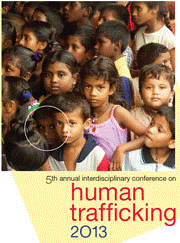Human Trafficking, Interdisciplinary Conference on

Annual Interdisciplinary Conference on Human Trafficking: 5th (2013)
Date of this Version
10-2013
Citation
A dissertation submitted in partial fulfilment for the degree MA, Human Rights and International Relations, Department of Social Sciences, University of Roehampton, 2012/06/08
Abstract
This study ultimately attempted to determine how useful quantitatively analysing secondary data is when studying human trafficking in individual countries. Two countries were chosen to analyse: Nigeria and Indonesia. Secondarily, the researcher tried to determine whether or not current human trafficking theory, which is based on international studies, can be applied when studying a nation individually. This study used content analysis to identify ‘hotspot’ areas of Nigeria and Indonesia. The researcher then used quantitative analyses of various secondary state-level data to search for risk factors that may be facilitating trafficking in these hotspot areas. In Nigeria, hotspot states were generally more developed and populated, less impoverished, and suffered from more crime. An explanation was offered for this, which said that Nigerian traffickers may be targeting highly populated and resourced areas because they provide better operation bases for their businesses. The crime culture of these areas may also allow the traffickers to operate more discretely. The researcher questioned if the nearly decade-long conflict in the highly prosperous Niger Delta was exacerbating trafficking in the area. Indonesian hotspots were characterized by large, dense, slowly growing populations. The proposed explanation for this result was that the hotspots were overpopulated and lacking in economic opportunities, creating a demand to emigrate of them and making residents vulnerable to traffickers. Indonesian problem areas were also found to have a higher proportion of females which was explained by the overwhelming amount of female victims trafficked from Indonesia. It was concluded that individual countries possess their own sets of risk factors which drive external trafficking. Based on this study, current trafficking theory should not be relied upon in analysing individual nations, but it can be helpful. The researcher determined that secondary data analysis of human trafficking is useful in creating a broad picture of the driving factors and generating research ideas.


Comments
Portions of this research were presented at Fifth Interdisciplinary Conference on Human Trafficking, Lincoln, Nebraska, October 12-14, 2013.
Copyright (c) 2012 Mark Ryan.